Not long ago, if anyone had asked me if I believe it is acceptable to ride elephants, my answer would have been a resounding “NO!” My point of view was challenged this past November, when the Tourist Authority of Thailand (TAT) invited me on a press trip to learn more about the care of elephants in the Kingdom.
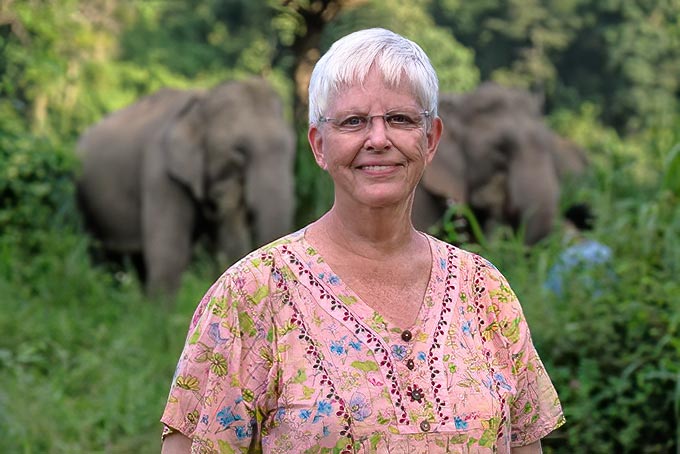
Elephants have been an integral part of Thai culture for centuries. Kings rode them into battle. Members of the Royal family and wealthy businessmen used them as a mode of transportation well into the 20th century. Elephant riding diminished once cars and motorcycles entered the picture, but by then elephants had become essential to the teak industry. With no roads carved into the dense jungles, they were the only animal strong enough to drag the immense logs to the river, where they were floated down to Bangkok. For decades, logging companies rented elephants and their “mahout” owners to do this back-breaking work.
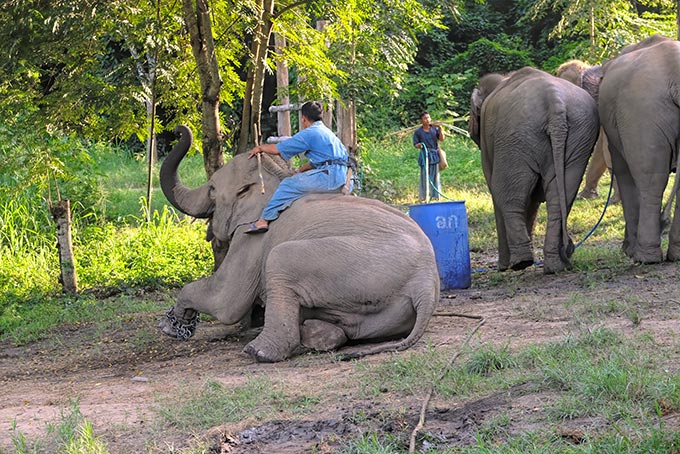
By 1932 the teak industry was in decline in Thailand and in 1989 all logging was banned. Gradually, mahouts and their families lost their means of earning a living, and thus the means to feed their elephants. Some turned to illegal logging, where it was not uncommon for the animals to suffer broken backs or fall off cliffs. A few were rented out to entertainment venues such as circuses and cinemas. Many mahouts roamed the streets of Bangkok with their elephants, begging for donations. It was a horrible existence for animals unaccustomed to traffic, noise, and asphalt and concrete surfaces.
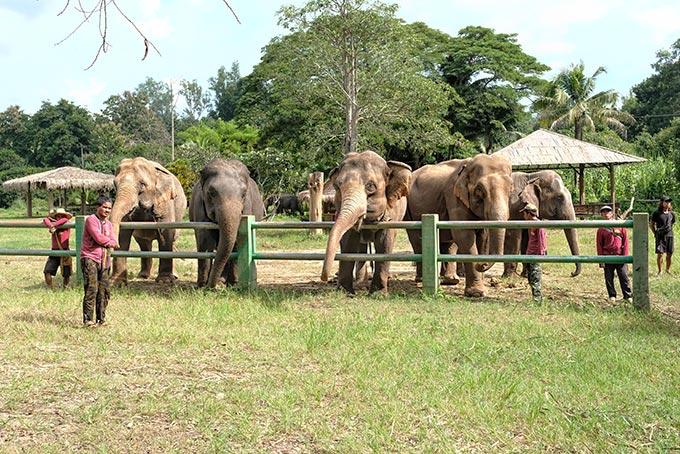
Today the majority of domesticated Thai elephants are engaged in the tourism industry. According to TAT, more than 80% of all tourists who visit northern Thailand will visit an elephant camp or sanctuary. Until recently, the opportunity to ride elephants has been on most everyone’s bucket list, while feeding, bathing, and accompanying elephants on a trek through the jungle have also been popular activities. Elephants have been trained to stand on their hind legs, to reach out with their trunks and kiss people on their cheek, and to paint pictures on canvases, and even to play musical instruments…all for the benefit of tourists. There was little discussion about the ethical treatment of elephants until a few years ago, when Lek Chailert, owner of Elephant Nature Park, began campaigning to end riding elephants and using ear hooks to control them.
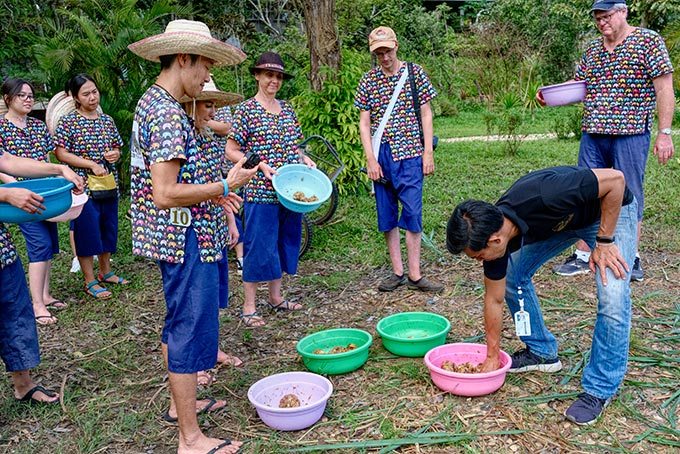
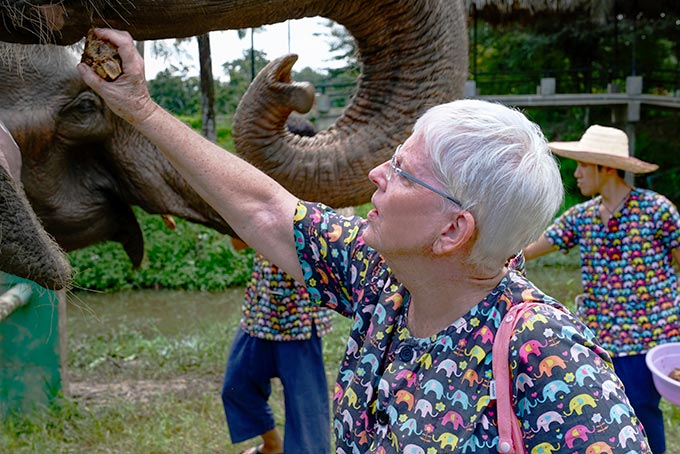
But I’m getting ahead of myself. Let me go back to 2007, when I rode an elephant up a hill at Angkor Wat, Cambodia, to see the sunset. I turned around to snap a photo of the elephant behind me and was horrified to see a mahout pressing a pointed, metal-tipped stick into the forehead of his pachyderm. The poor beast obviously did not want to climb that hill. I turned back to the elephant I was riding, leaned down and whispered, “I’m so sorry. I promise I will never ride elephants again.” And I didn’t. My conviction that elephants are wild animals that should not be forced to carry passengers was only strengthened some years later when I visited Elephant Nature Park in northern Thailand.
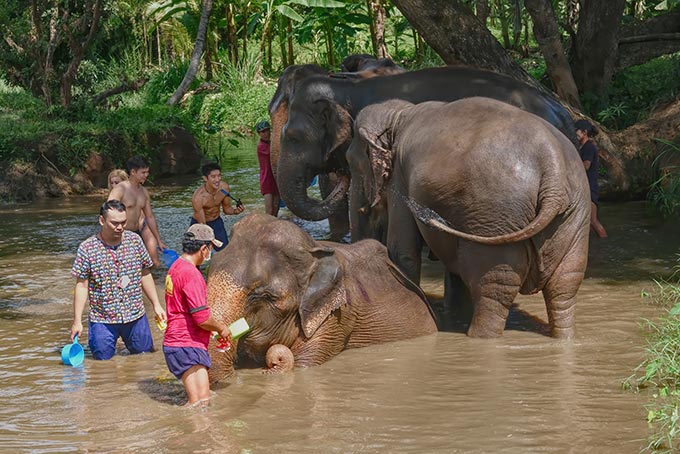
When I was invited on this “Elephant Care Experiential Learning Trip,” I expected the focus to be on humane treatment of the domesticated herds in Thailand. The itinerary stated, “In this trip, we want to show the current situation and how we can, collectively, move forward towards more sustainable solutions for elephant-based tourism in Thailand.” Over three days we visited an elephant hospital and two elephant sanctuaries. On the third morning it became clear to me that Thailand supports elephant riding and even training elephants to paint or play musical instruments. I was surprised, but willing to hear and consider their point of view. We met with a group of veterinarians and handlers who had been researching stress levels and the physiology of elephants for more than a year.
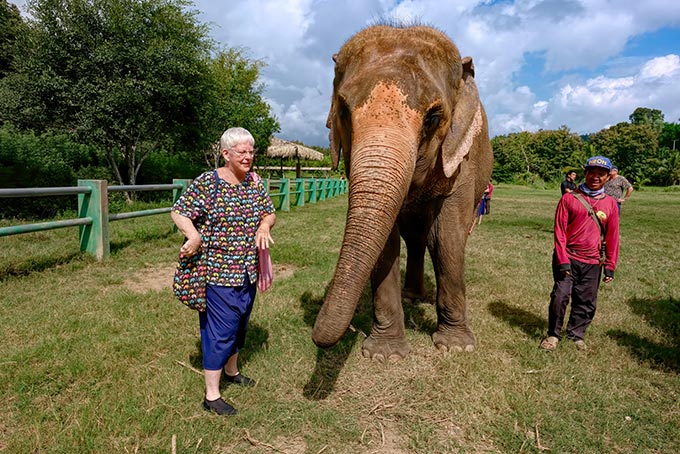
The researchers made some good points. Domesticated elephants can never be released. Not only do they not know how to survive in the wild, they would most likely be rejected or even killed by wild bull elephants, who are already suffering from shrinking habitat due to deforestation. Females who have lived their entire lives in captivity are incapable of teaching their babies how to survive in the jungle, thus the domesticated herd continues to increase in number. It costs between 1,000 and 1,500 baht ($30-45) per day to feed an elephant. Multiply that by 3,500 domesticated elephants in the Kingdom and it becomes obvious that tourism is crucial if the elephants are to be properly cared for.
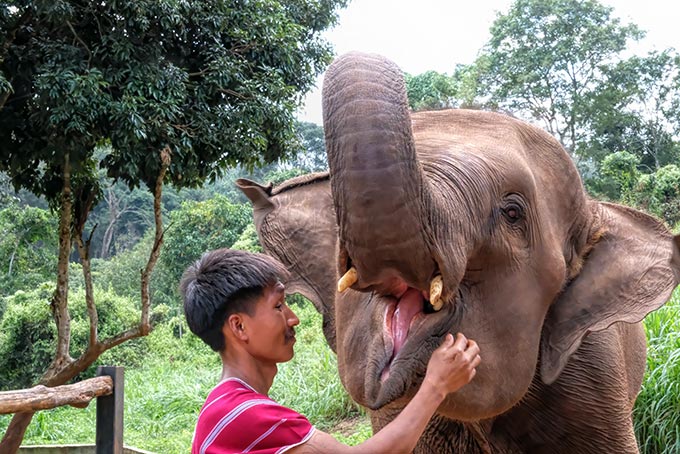
But the question remains, what is considered proper care? According to the researchers, an elephant can safely carry up to 20% of its own body weight. Their bones have no marrow. They are solid rather than hollow like human bones. Additionally, for more than a year the vets have been drawing blood samples to monitor the stress levels in elephants. As might be expected, elephants feel more stress during the tourist high season than low season. But counterintuitively, elephants that are allowed to roam freely in the jungle at night were found to have higher stress levels than those are kept in pens, chained by their feet, and provided with sufficient food. Frankly, I was unconvinced. I questioned how they had established a baseline for stress levels but didn’t receive an answer and the data for their studies were not made available.
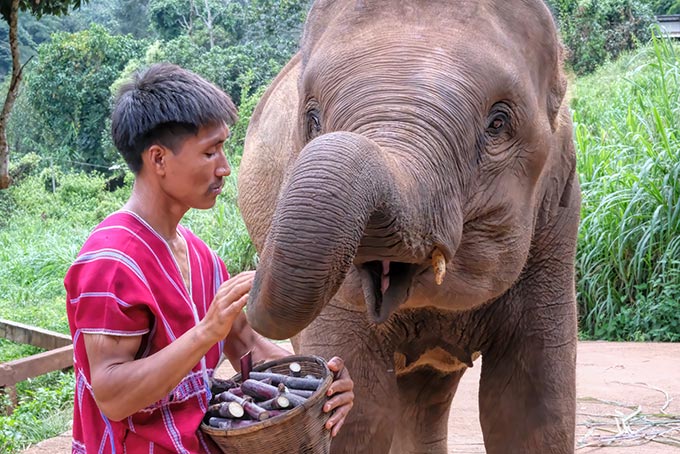
I admit to being conflicted by the issue of what constitutes proper interaction with animals. Where do we draw the line? Should we be riding horses? Or camels? Should buffalo and oxen be used to plow fields in developing countries? Though the terms wild, domesticated, and tame are often used interchangeably, they have very specific definitions. Domestic animals are those that have been selectively bred over many generations to make them better-suited to living alongside humans. Dogs, cats, sheep, pigs, turkeys, donkeys, camels, cattle, and horses fall into this category. Wild animals live and breed in their natural environment without human interference. In-between these two categories are animals that have been tamed. Over time, their behavior changes due to the close proximity with humans, though they can still exhibit wild behavior. Thailand’s “domesticated” elephants would more correctly be described as tamed animals.
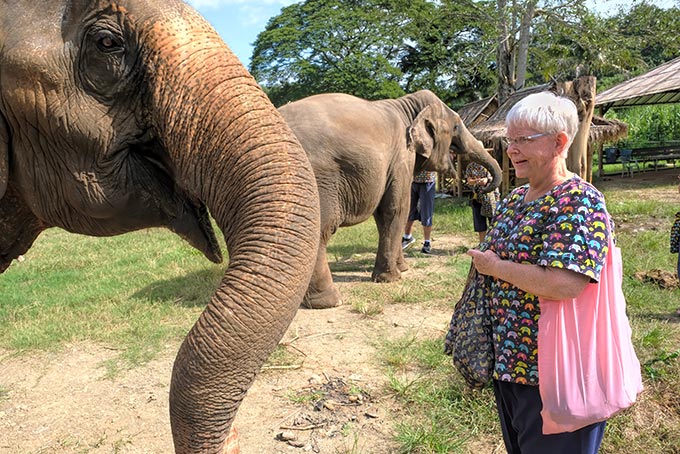
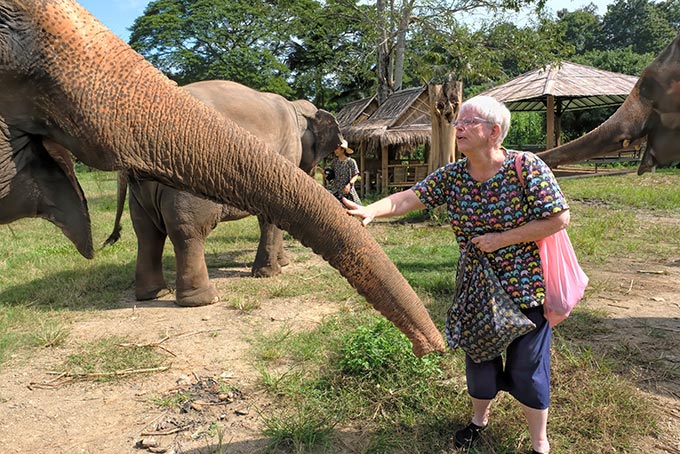
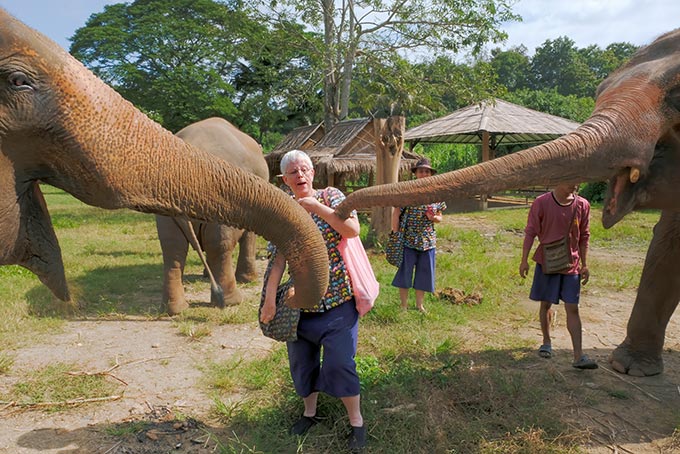
Any conversation about what constitutes appropriate interaction between humans and domesticated or tamed animals must take into account the methods used to train the animals. In the case of elephants, the internet is full of horrific videos of baby elephants being torn from their mothers at a tender age and subject to a ritual known as Phajan, which translates to “crush cage.” The baby is stuffed into a small bamboo enclosure and all four legs are tied to the corners of the cage. It is beaten with sharp tools and screamed at constantly. Bullhooks are often used to stab the elephant’s head, slash the skin and tug the ears, to the point that portions of the ears may be ripped away. The young elephant may be stabbed, burned, and deprived of food and water. This goes on for days, sometimes for weeks, until the elephant’s spirit is broken and they are under the complete control of their handlers.
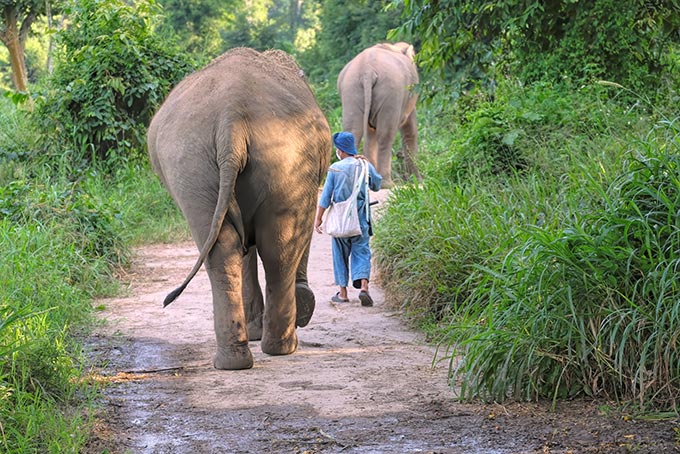
Representatives of the camps we visited told us they never conduct Phajan ceremonies. Young elephants are never separated from their mothers, and only positive reinforcement training techniques are used, though bullhooks pushed through holes in the elephant’s ears are still used as a means of control. I also saw several that were chained, including one big female at the hospital that was hobbled, with both front feet chained together. The vets insisted it was necessary, as she was extremely aggressive, but it still broke my heart. However, the training of “domesticated” elephants in Thailand is much more humane than in most other areas of the world.
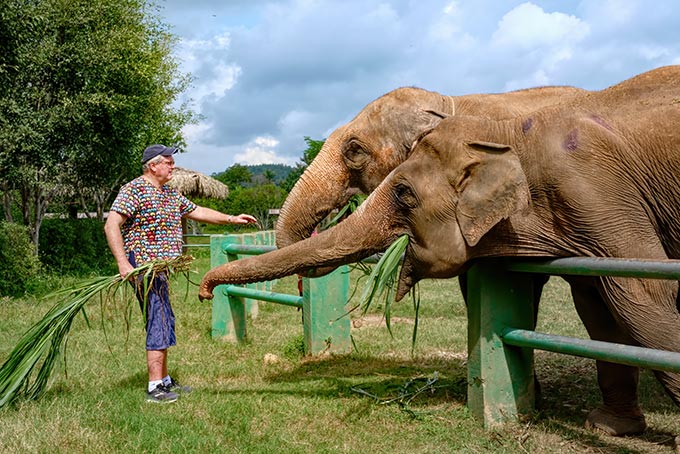
I can’t offer an opinion regarding whether it is ethical to ride elephants. In the end, every person must decide for themselves. For me, the answer is still no. I will never ride one again, nor would I choose to visit any camp that trains elephants to do circus tricks or paint canvases. On the other hand, I see no harm in feeding elephants, walking with elephants, or even bathing them in a river or pond. At Kanta Elephant Sanctuary I was told that the elephants would interact with us as long as we had food for them. Once the food was gone, they would turn their backs and walk away. Indeed, that is exactly what happened. Later that morning, scrub brushes in hand, we waded into a muddy pond with the herd and helped bathe them. There was no doubt in my mind that the elephants not only enjoyed this interaction, they luxuriated in it.
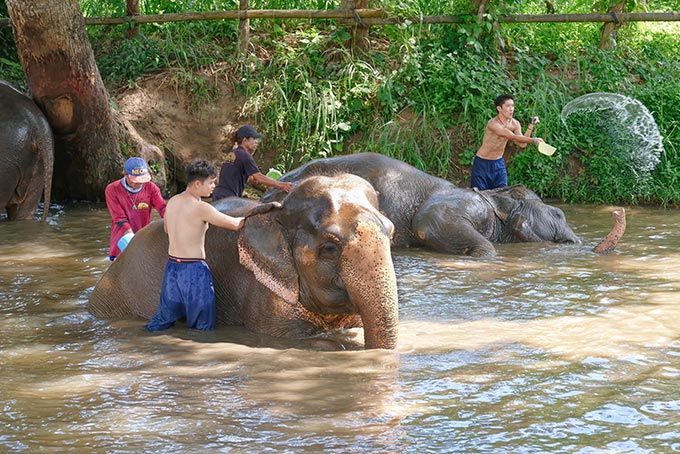
All three of the camps we visited had excellent facilities, but Kanta Elephant Sanctuary in Chiang Mai was my personal favorite. Their website states, “Our hope is to lead by example, and contribute to a positive change in the perception of elephants; to witness a future where elephants are not ridden, poached, overworked, or abused, and are instead treated with care, love, and respect.”
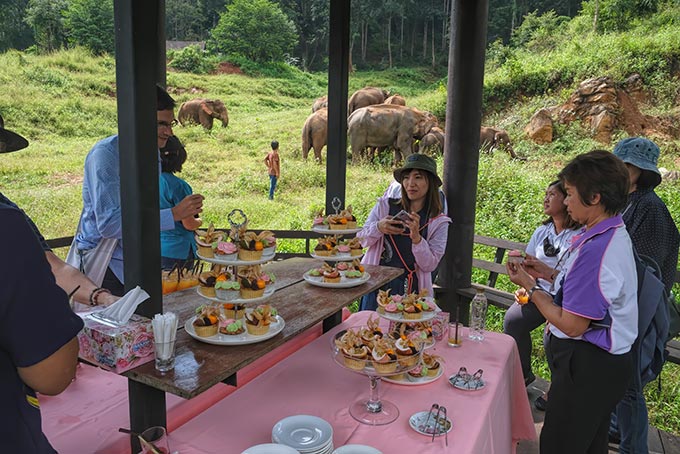
The Thai Elephant Conservation Center in Lampang Province offers elephant rides and also puts on a 40-minute show three times a day, which “highlights the agility and intelligence of these graceful creatures.” TECC is the first place in Thailand where elephants were taught how to paint and it’s also home of the Thai Elephant Orchestra. As well as producing paintings and music, the elephants demonstrate techniques formerly used in the logging industry.
While Patara Elephant Farm in Chiang Mai does offer guests the opportunity to ride elephants, they also offer an intriguing “Elephant Owner for a Day” program that trains participants how to approach an elephant correctly, recognize its temperament, feed and check its health, bathe and brush it in the river, how to ride on its neck, and how to communicate through different spoken commands.
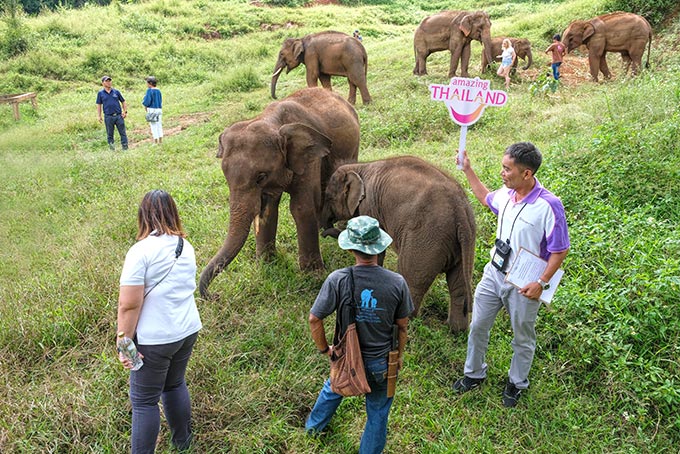
Elephants will always be important in Thai culture. Not only is it the national animal of Thailand, elephants are a sacred animal in Buddhism. They are widely depicted in artwork, written about in literature, and included on national emblems. The provincial seal of Chiang Mai features an elephant in a glass palace. There is Chang (Elephant) Beer and Elephant Brand Thai Jasmine Rice. There is even an Elephant Brand Cement. With more than 3,500 domesticated elephants in the Kingdom, more babies being born every year, and an average lifespan of 50 years, Thailand will be struggling over how to manage the herd for many decades to come.
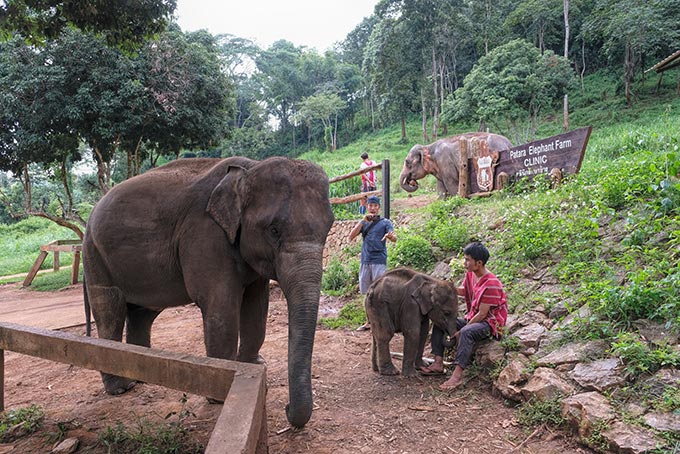
Perhaps the most intriguing idea I heard during the press trip came from fellow travel writer Jenny Littlewood, who asked whether sterilization of domesticated elephants had ever been considered. Though a long-term solution, it would gradually reduce the herd as older elephants died. The room fell quite silent for a moment and no answer was forthcoming. Later that day, the answer became obvious to all of us when a mother elephant and her two babies wandered into our circle. We all oohed and aahed and posed for photos with the adorable youngsters. Let’s face it, adult elephants are impressive, but baby elephants are terminally cute. It’s the babies who draw the tourists. And that means the Kingdom of Thailand will continue to breed the domestic herd and pursue elephant tourism, riding and all, for the foreseeable future.
You may also enjoy:
My visit to Elephant Nature Park in Mae Taeng, Thailand
Visiting Siem Reap, Cambodia, including my first and only elephant ride at Angkor Wat
From Digital Nomad to Expat – Putting down roots in Chiang Mai, Thailand
I was a guest of the Tourist Authority of Thailand during this three-day trip to learn about Elephant Care in the Kingdom of Thailand. However, the receipt and acceptance of complimentary items or services will never influence the content, topics, or posts in this blog. I write the truth, the whole truth, and nothing but the truth.

I read the whole article. Elephant riding was a small part of your discussion. The three camps you say have \”excellent facilities\”…offer riding, bathing elephants multiple times a day, painting and breeding. You mentioned bullhooks pushed through the holes of the elephants ears to control them. Are the above acceptable to you? You do not highlight sanctuaries that do not participate in the above. There are several. Have you considered, breeding or allowing breeding is to draw in tourists and the cycle continues? One more mouth to feed, more tourists needed. A press trip may not be the best way to get a balanced view or speak with experts on elephant welfare.
Some sanctuaries that put elephant welfare first AND provide for them and their mahouts- Elephant Nature Park, Asian Elephant Projects. Somboon, Boon Lotts, Samui Elephant Sanctuary, Chang Chill, Kindred Spirits Elephant Sanctuary, Burn and Emily’s, Phuket Elephant Sanctuary, Following Giants, Mandolao
Be part of the solution, not the problem
Supporting true sanctuaries moves others in the ethical direction. Research suggestions even if from a well meaning person.
Hello Laura: Apparently you have NOT read my whole article. I, too, am opposed to riding elephants, to crush training, to the use of ear hooks, to forcing elephants to paint and perform circus tricks. I criticized TAT quite harshly for their support of and promotion of operations that provide these services. I promoted Kanta Elephant Sanctuary, one of the facilities we visited on the press tour, because they do not do any of the above mentioned activities. Yet you say that Kanta is not an ethical operation. How much research did YOU do? My story was an even-handed, thorough discussion of the pros and cons, and at the end I said that, based on the facts, everyone should be able to make their own decision. However I added that for me, I will never support any elephant tourism that provides these activities. This is what good journalism is all about. A presentation of the facts which then allows the reader to make up his or her own mind.
Hello Laura: Apparently you have NOT read my whole article. I, too, am opposed to riding elephants, to crush training, to the use of ear hooks, to forcing elephants to paint and perform circus tricks. I criticized TAT quite harshly for their support of and promotion of operations that provide these services. I promoted Kanta Elephant Sanctuary, one of the facilities we visited on the press tour, because they do not do any of the above mentioned activities. Yet you say that Kanta is not an ethical operation. How much research did YOU do? My story was an even-handed, thorough discussion of the pros and cons, and at the end I said that, based on the facts, everyone should be able to make their own decision. However I added that for me, I will never support any elephant tourism that provides these activities. This is what good journalism is all about. A presentation of the facts which then allows the reader to make up his or her own mind.
Hello Barbara Weibel,
I just wanted to say thank you so much for your brilliant article. Elephants are such beautiful and majestic creatures and you are so lucky to have been able to do this (to be honest, I am a little jealous as I would love to do this myself, the feeding and bathing)! I cannot say how much this article helped me and finding someone who looks at both sides of the story non judgmentally like you have to help find an answer. I learnt about pajhan a while ago but I remember seeing a TV program where the people were helping the elephants and their calves and the mahouts (which I believe is/was STEF, the Southern Thailand elephant foundation) and I thought, the way the people treated them with such love and kindness, I thought surely they wouldn’t have used phajan on the elephants and must have had a cruelty free way of interacting with them so when I found this article, you literally helped answer so many of my questions for me. Thank you so much!! I am unsure of whether I would ride an elephant myself but I completely understand your reasons and thank you but I would definitely love to ethically feed and bath one!!
Hi Angie, I really like your blog, and I find you opinion interesting, i am actually a Half Thai myself, I think people need to understand, riding elephants is part of Siamese culture it is a Buddhist culture as Thailand is the only Buddhist country that never colonized or communist our culture is very much still intake. It will always be part of our history and we proud of it. For westerners to tell us it bad riding elephants basically also like a insult to our king too . king bhumibol adulyadej funeral had manhunt on white elephant riding them and marching them in sync, very similar to what you might call a circus act, but to us thai it’s pride that we can co rain our tradition. By the wa a white elephant is a rare kind of elephant, but not a distinct species. In Hindu puranas, the god Indra has a white elephant. Basically people should understand this is thailand and if the king is ok then I am ok. As a Thai we don’t really care about westerners opinions, as Thai we never had problem with Chinese or Indian tourist or Asia tourist only western people criticize. You westerners love to get involved and destroy culture, that why you send warships to South China Sea. If Muslims want sharia laws respect their culture and traditions don’t go disrespecting it and invading countries to implement your western idea. Same respect thai culture don’t try implement your ideology on us. Why you western love to catch fish with those hooks and then weigh it and throw it back in river that cruel, most Asian countries are poor we would not hurt fish for fun or entertainment but actual eat it to survive. You see our culture are different. Respect Siamese heritage
I am a bit late with this post but I, too, have been a guest of TAT (we were there for a business trip with TAT as our sponsor about 10 years ago) and was taken to one of these parks. Most of our group (from the US and Europe) were not supportive of the use of these magnificent animals for human entertainment and said so in a respectful way. But little has changed over the years.
Now, during Covid and travel restrictions, the Elephant Nature Park/Thailand have had a terrible time trying to feed the elephants. Many were starving. I volunteer and have supported for many years an organization called The Center for a Humane Economy affiliated with Animal Wellness Action. They are raising thousands of dollars to help feed these elephants. Here is our most recent fundraising message:
“We want to keep the support flowing to feed these elephants. In the long run, we want to see the elephants transitioned from arduous work, rides, and circus acts and deplorable living conditions and placed in sanctuaries that can offer tourists an experience that does not cause harm to the elephants. But in the short run, we need to keep them alive.”
Animal welfare advocates such as myself and many others know that sometimes to get to the good side of a bad situation, it requires many twists and turns on the road to get there. Barbara, you seem to understand this concept in writing this article from the heart but also a sense of reality. Thanks for being out there and keep on traveling again when you can!
Thank you so much for your kind comment Susan. I tried had to look at all sides and report fairly on this issue. There are too many entrenched opinions these days, in my opinion. Probably my biggest beef with Thailand’s program is how hard they are trying to bring new baby elephants into the world. The proliferation of tame elephant herds flies in the face of their arguments that tame elephants cannot be released to the wild. If true, why continue to increase the numbers that require care for up to 100 years?
There will always be idiots who think that riding an elephant is ok. Maybe the mahouts should be sacked and the elephants set free. They are not for human entertainment.
Hi Aggie: While I agree that elephants tourism programs should not offer elephant rides, calling people idiots is not civil or productive. This is an issue that demands education, not name calling.
Fantastic article! Very nicely put up. However, I do strongly feel that no matter howsoever the elephants get treated in a humane way, they still deserve to be in the wild, with their other wild companions.
My answer will always be a no…riding an elephant, camel is a straight no.
Me too Anukrati
Hi Barbara,
This is one of the first times I ever read a travel blogger offering a fair, balanced and emotionally-poised perspective to the animal tourism industry. Excellent job. Few travel bloggers have wisdom, poise and open-mindedness enough to understand the perspective of tourists, people who own these establishments and of the elephant’s themselves.
I received hell from travel bloggers for visiting Tiger Kingdom in Chiang Mai a while back but Kelli and I researched the place, how they treat tigers and paid close attention to a farang who actually worked their for months. She was there. The critical travel bloggers projecting their own internal struggles and fears with self, were not.
The quickest way to come to a workable solution for all sentient beings involved is to understand all perspectives. From there, we work together for the best of all.
Brilliant post!
Ryan
My dear friends Ryan and Kelli: Thank you so much for your comment. You can’t imagine how much I appreciate it. As you know, I try to focus on culture in my travels and my subsequent writings. During the last 14+ years of travel, I have encountered many situations where I struggled to see things through a lens of the local culture rather than apply my western mentality and viewpoint. Sometimes I challenge the situation, sometimes I accept it as just being different. But moreoften than not I stay neutral and try to look at all sides of the issue, as I did in this case. I’m truly grateful that you understand this, and that you took time to leave such a lovely comment.
Wow! That’s an amazing experience. Would definitely love to try feeding those elephants.
I loved feeding them, though their massive size can be a little intimidating. Hope you get to do it one day.
I spent some time at the Elephant Nature Park (about 60km? north of Chiang Mai), which saves elephants, dogs, cats, water buffalo etc… They certainly don’t agree with your sponsors. They would never allow babies, riding or trained shows. They had parks around them that did such. They justified it by saying they needed the money to feed the animals. ENP was trying to teach them, that they too could be successful (like ENP) by following their program. Thank you for your article – it reminded me that Covid has probably hurt ENP financially and they could use some financial assistance. Best regards
Hi Connie: Thanks for your comment. We need to understand the whole scope of the issue – both sides of the argument – in order to make informed decisions.
I think you’ve given a balanced view of this complex issue Barbara, it’s not a black and white issue. I’ve not visited Thailand, but I’m generally a lot more thoughtful about animal based tourist attractions when I travel thank I might have been a few years ago. I’d not personally ride an elephant and would be wary of shows that include elephants painting and other tricks. However I would love to see elephants in a more natural setting and learn about their context in Thai culture. So I wouldn’t rule out visiting an elephant sanctuary but I’d want to do my homework before doing so.
Fantastic article, Barbara! I, like you, rode one on my first trip to Thailand, and after learning more of the culture, decided I wouldn’t repeat it. But visiting a nature park would definitely be in my radar on my return to CM. Thank you for this enlightening read!
Don’t justify riding an elephant. Maybe interacting with them. There are plenty actual sanctuaries that have zero interaction and still make money to care for them.
I understand baby steps but moving forward is hard when travel bloggers continue to say, well maybe and then support it.
Sterilization? No and not just because baare cute.
Kym, it seems to me that you did not read my article in its entirety. I did not justify riding elephants. In fact, I said I still would not personally do so. But it is always valuable to look at all sides of an issue and that is what I tried to do in this article. Intelligent discussion and conclusions cannot be drawn until and unless the views of vets, scientists, researchers, and government agencies are known and understood, in addition to those of animal rights activists.
Fantastic article. A really interesting and balanced look at an industry that has a lot of grey area.
Elephants are one of my favorite animals and I’d be lying if I said I’d pass on interacting with one up close and personal. As that might be a touch dangerous to pull off with a wild elephant, the only other option would be with a tame one. But their mistreatment would put me right off that idea.
If there’s a balance that can be struck, the elephant’s wildness for a humane captive environment, that’s probably the best one can hope for. The inability to return the elephants to the wild makes it incumbent on people to continue to care for them. They’re not cheap to look after and there’s no more “work” for them in industry, so tourism is their only ticket to survival.
I replied at length to the comment you left on my Facebook Page, but just wanted to say thanks again for your comment John. Some are criticizing me without even reading the whole article. Sigh. It’s just the times we live in.
Such magnificent creatures! What a wonderful experience this must have been!
It definitely was, Vivian. I am in awe of these highly intelligent, massive creatures!